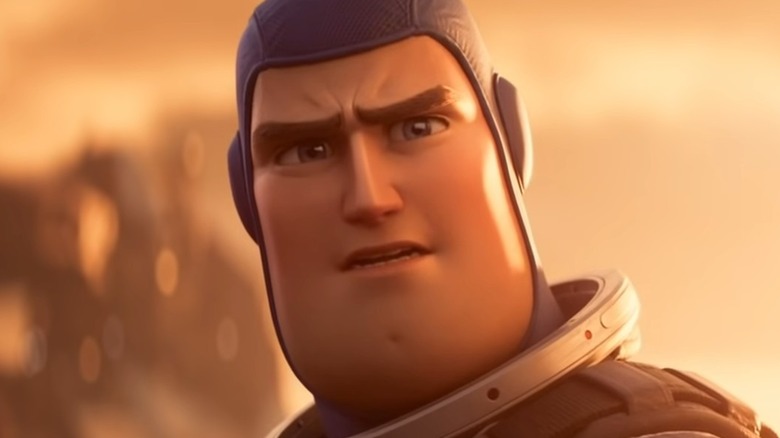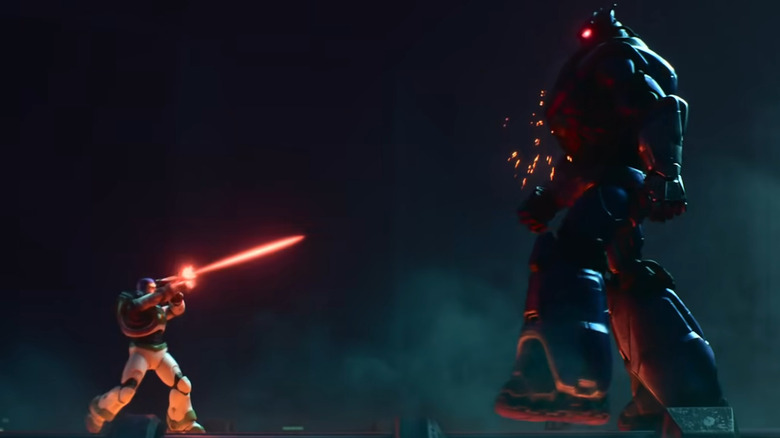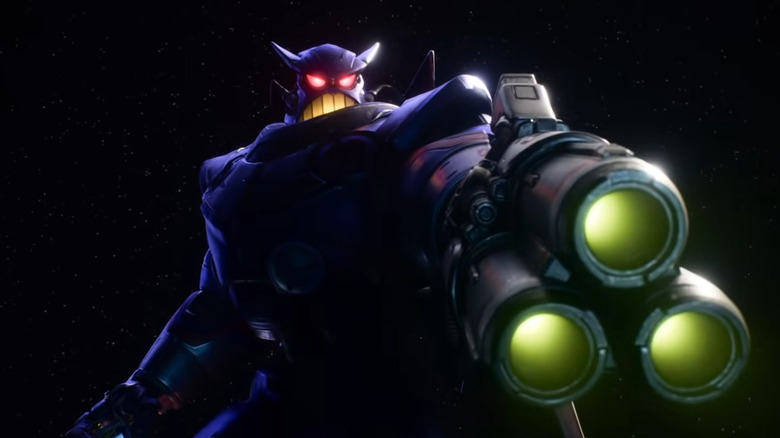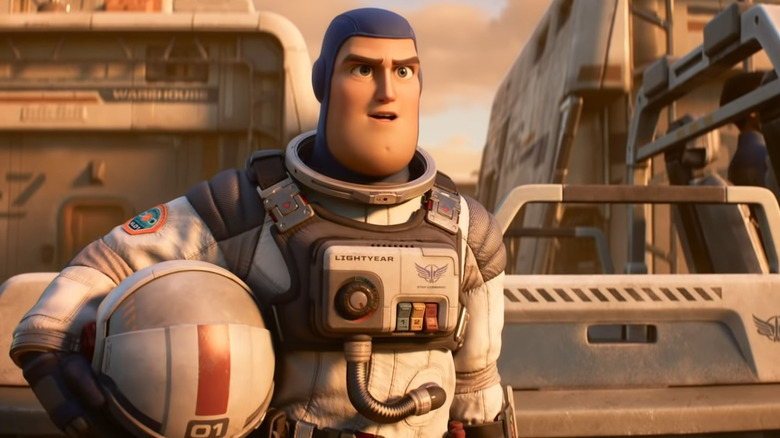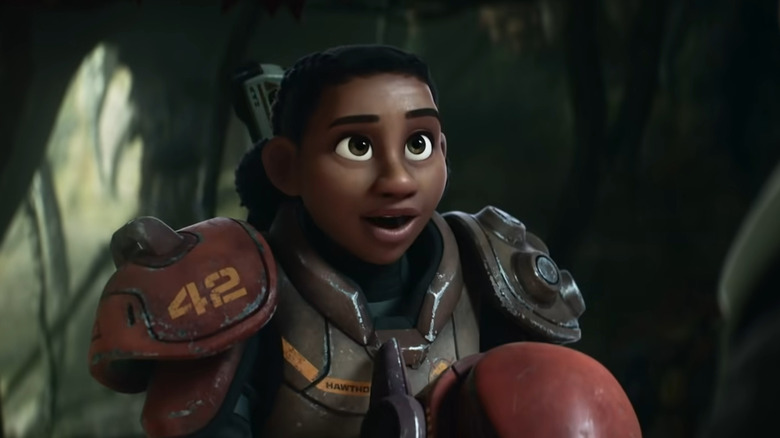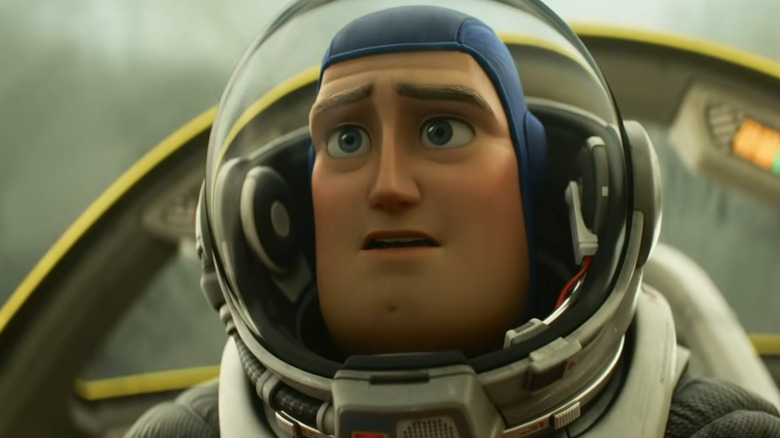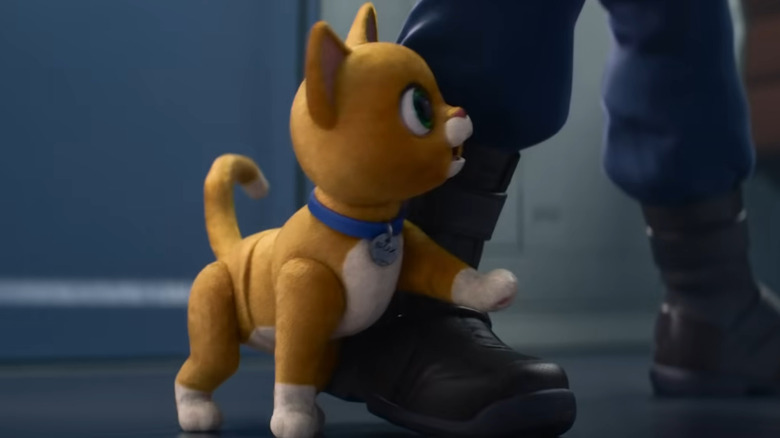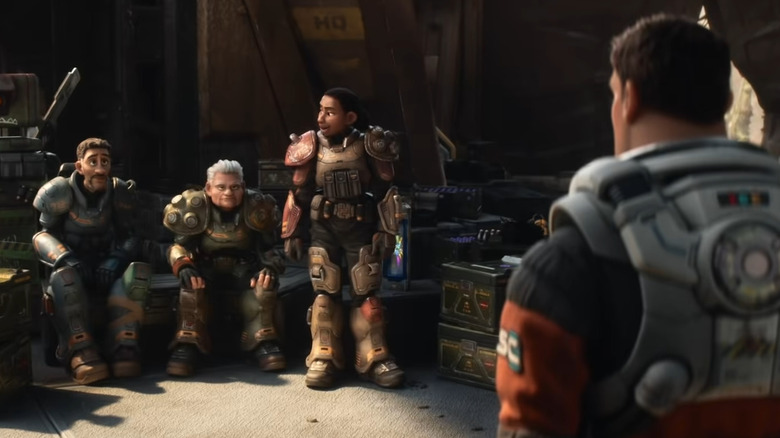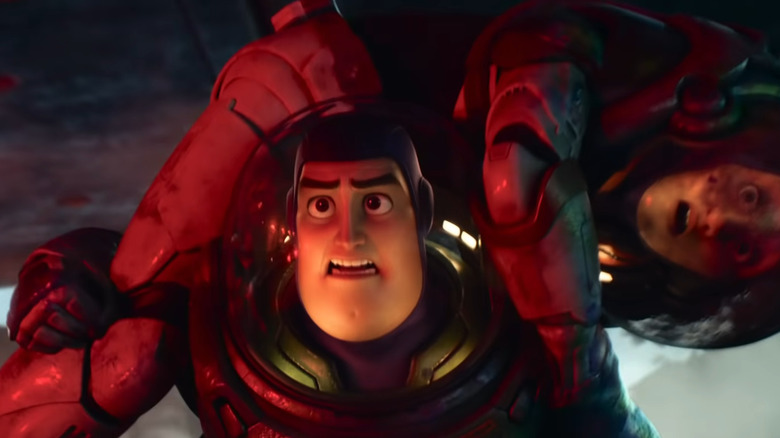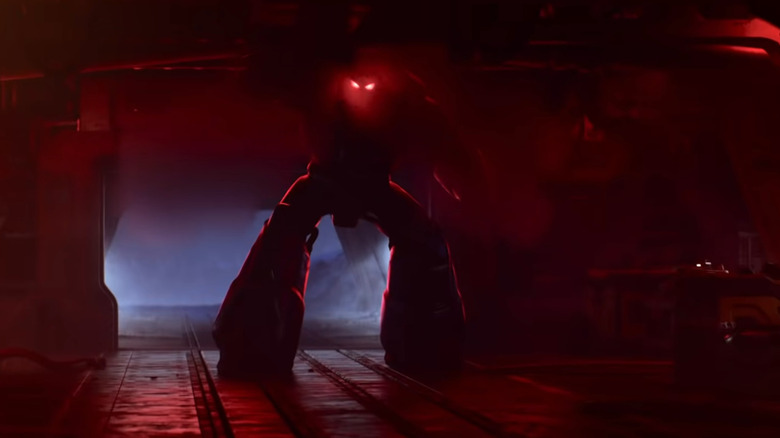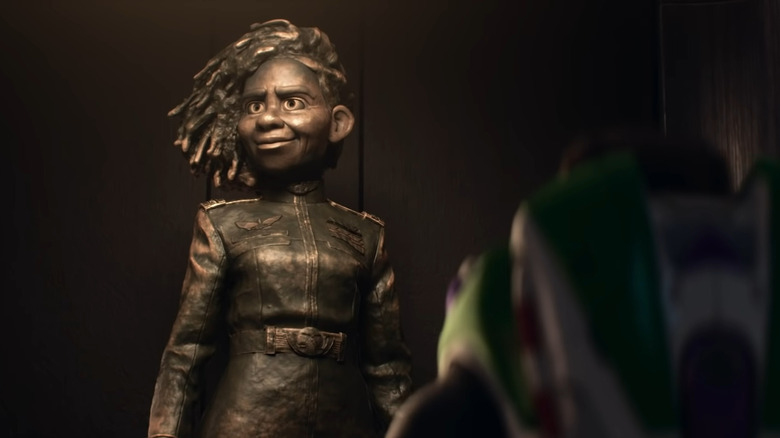The Ending Of Lightyear Explained
Every character has an origin story — even if that character is a children's toy. Pixar's "Lightyear" is that origin story for "Toy Story" co-protagonist Buzz Lightyear (Chris Evans), the hottest action figure of 1995. While the film does feature a lot of references and tie-ins to Buzz's prior franchise, "Lightyear" is largely an independent story. It pulls equally from retro science fiction and Pixar's early films, resulting in a movie that delivers a worthy spin-off for a fan-favorite character.
The opening of "Lightyear" explains that it's actually an in-universe film released in the "Toy Story" timeline — a movie so popular in 1995 that it made Buzz Lightyear figures the hottest item on the market for kids. The story follows Buzz and the massive Star Command vessel he's stationed on over the course of a century. After a terrible crash-landing, the ship's 1,400 inhabitants are forced to build a colony on a hostile world while trying to devise a method of returning to the cosmos. Buzz takes that mission more seriously than anyone, leading to a warped timeline and a dangerous obsession that nearly brings the whole colony down.
"Lightyear" is a movie about a lot of things. It's one character's journey of discovering the dangerous of fixation and the limits of success. It's about learning to live with the past in order to live in the present. And, of course, it's about Space Rangers battling the Evil Emperor Zurg. By the end of the movie, a lot has happened, and there a good number of twists along the way. Here's what actually happens at the end of "Lightyear" and what it all means.
The Zurg twist
Every hero has a villain, and in the case of Buzz Lightyear, that villain has always been Zurg, the bull-horned, purple-clad conqueror with the tri-barreled plasma (or foam ball) blaster. "Lightyear" brings a big twist to the bad guy in the film's third act by revealing that this instance of Zurg is actually Buzz himself. Specifically, he's an old version of Buzz from a split timeline who journeyed far into the future and then back again using advanced technology. Old Buzz's plan is simple: He wants to use the crystallic fusion drive to go back in time before the Star Command ship ever even crashed, thereby erasing what he sees as his greatest failure.
As it's explained in the film, the first time Buzz successfully achieved hyperspeed, he returned home expecting a hero's welcome. Instead, he was brought up on charges for going against Star Command orders. In a daring escape, he flies over a hundred years further into the future and discovers a ship that holds the Zurg armor and robots. Using the advancements available in that far-flung future, he's able to travel back in time, but only as far as his original hyperspeed voyage. That leap back in time creates a paradox of two Buzzes and gives the younger Space Ranger a shot at redemption.
Obviously, Zurg being Buzz is a bit of a retcon. In the old cartoon that followed "Toy Story," the villain was simply an evil emperor. However, the twist brings an interesting new layer to the story, turning Buzz's obsession with success into a dark alternate plot line. As it turns out, Buzz Lightyear's greatest enemy is actual his own worst self.
A dangerous obsession
One of the biggest themes in "Lightyear" is obsession. It's explored early on in the montage of Buzz's many hyperspeed test runs. In each attempt, he moves four years into the future, returning home each time to a colony that has advanced and changed in many ways. It's one of the film's most powerful moments because it shows just how far Buzz is willing to go to achieve what he views as success and redemption. He has friends on the planet — at least one, anyway — but that's not enough to make him want to stay. He values his legacy and his reputation more than he values his own happiness, and he willing blows through almost a century of time while hardly aging at all.
The revelation of Zurg's true identity puts Buzz's obsessive nature into stark perspective. The younger character sees his older self in all of his sadness in regret — a man who was so fixated on making his life perfect that he forgot to actually live it. "I'm going to go back and matter again," Zurg says at one point, blind to all the harm he's already caused. The lesson that younger Buzz ultimately takes away is that obsession always leads down a dark path. He realizes that it's better to live in the world you've got than to spend every waking hour thinking about what you could have done differently. After all, despite all your effort (and futuristic technology), you can't really change the past.
You can't change the past
For a hot second, it looks like Buzz might take Zurg up on his offer to help him undo their previous timeline. It's the thing that Buzz has been trying to do for so long — fix his mistake, restore his reputation, and set things right as he understands them. But then he realizes the magnitude of that decision. He realizes that his best friend would never have had the life she ended up living — a life filled with laughter and love. Her children and grandchildren would never be born, and countless others would befall a similar fate. For all of Buzz's desire to see his mistake mended, he realizes that the stakes of turning back the clock are too great. Zurg doesn't like that kind of thinking, though, and they too engage in an extended battle that ultimately ends in the villain's defeat.
The implicit message here is a pretty heavy one, but also a simple one — you can't ever undo your failures, and that's just part of life. With enough time, mistakes just become part of history. They become a part of your legacy, which isn't necessarily good or bad. Would Buzz and Alisha (Uzo Aduba) have lived happier lives if they'd never crashed on the planet in the first place? It's impossible to know. We all only get one life, the movie seems to say, and it's better to enjoy it, errors and all, than to lament some other life that might have been. This is perhaps best illustrated in the film's third act, when Sox is preparing Izzy for an airlock jump. "Once you push off," he says, "that's the direction you'll go."
Overcoming oddities
When Buzz jumps forward in time and discovers the presence of Zurg's robots, he teams up with the only folks he can find to fight back: His best friend Alisha's granddaughter Izzy (Keke Palmer), a nervous man named Mo (Taika Waititi), and an elderly ex-convict named Darby Steel (Dale Soules). Together with the assistance of Buzz's robot companion Sox (Peter Sohn), the team attempts to take Zurg down, but they hit a number of pitfalls along the way.
Many of the problems that the team ends up facing are products of their own mistakes — a recurring theme in the movie. Mo's nervousness leads him to make some errors, Darby is a little too gung-ho, and Izzy's excitability causes her to mess things up a couple of times. And yet, in true Pixar fashion, those apparent faults end up being turned into assets by the end of the movie.
Whether it's Mo's love of the surrender switch on his Space Ranger suit or Darby's ability to make anything explode, the qualities that make each character eccentric and odd are also the ones that help them get the job done. It's not exactly a new idea for a children's movie to espouse, not even within the Pixar pantheon, but it still works quite well in "Lightyear." Buzz's hyper-fixation on a single idea of the right way to do things is broken by the oddities of those around him. As it turns out, diversity of perspective and experience ends up being a positive attribute for the team. Who would have thought?
Finally at home
After successfully stopping Zurg's evil plan and destroying his ship, Buzz and co. return to the colony, where they're welcomed as heroes. Buzz explains that he feels okay about never managing to get the Star Command ship back into space, because he realizes that they've all made a home together on this strange alien world. The perseverance and determination of the other human inhabitants seems to inspire him, and he takes solace particularly in the company of his new friends.
Up until this point, Buzz never seems content to sit down and actually live his life. That may be in part because of his natural personality — one that doesn't lend itself easily to building relationships — but it's also implied to be connected to his sense of self-worth. In the middle of the movie, Buzz shares how he was a major screw-up at Space Ranger boot camp, and that he planned to quit after the first week. He was eventually convinced to stay by Commander Hawthorne, but it's clear that he still carries that sense of inferiority with him. Maybe Buzz never thought he was worthy of a normal and happy life. Maybe he always believed that he had to accomplish great things in order accept joy for himself.
Fortunately, his interactions with Izzy, Darby, and Mo seem to break him out of that harmful stupor. He recognizes that all people are deserving of love, happiness, and second chances, which allows him to finally accept that he does have a home.
One big plothole
"Lightyear" is a solid movie, but it isn't without its faults, and there's an especially big one at the end of the movie in the form of a gaping plot hole. All of the action of the third act (and much of the movie prior to that point as well) revolves around the crystallic fusion drive that Buzz creates with Sox's formula. He's shown synthesizing the crystal at one point in the film, and he carries the same one through everything else. Zurg tries to use it to go back in time, but Buzz manages to swipe it back. Unfortunately, the MacGuffin shatters during Buzz's atmospheric reentry, leaving all the humans still stranded on the planet.
Buzz says it's okay that he couldn't complete his mission, but here's the thing — he could. Sox still has the formula that resulted in the perfect fusion crystal, and there are surely still enough resources on the planet to synthesize a duplicate (at least, there are no claims to the contrary). That means that Star Command could theoretically leave the planet if they just made another crystal, but nobody even entertains that idea. Maybe there's some other obstacle standing in their way, or some other reason why the crystal can't be recreated, but it's never properly explained in the film. This is a bit of a perplexing plot hole, but fortunately, it's not enough to ruin the movie or its overall message.
New Space Rangers
Though he doesn't get the rest of the humans back into space, Buzz does head up a major new initiative for Star Command at the end of Lightyear. Due to his heroics, he's commissioned by Commander Burnside (Isiah Whitlock Jr.) to head up the new Universe Protection Unit — a resurgence of the Space Ranger program meant to expand the influence and safety of the Galactic Alliance's burgeoning colony. Buzz is given the chance to pick his personal squad from the best of the best, but he instead declares that he already has his crew.
Decked out in a new generation of Space Ranger suits (the design that Buzz sports in the "Toy Story" movies), Buzz, Mo, Darby, and Izzy set out on their next mission. They may still be a little ragtag, but they're battle-tested and stronger than ever. The ending scene of them blasting off into space together could be the setup for a sequel, or even a series on Disney+. Given what happens in the film's post-credit scenes, those possibilities seem even more likely.
Toy Story tie-ins
There are a ton of "Toy Story" Easter eggs scattered across "Lightyear," but the film's ending features a couple notable ones in particular. Not only is the Universe Protection Unit mentioned by name in the original movie — Buzz claims to be a member of that group specifically before he accepts that he's a toy — but the specific mission he and his team embark on also ties directly into Pixar's feature debut.
In the first "Toy Story," Buzz says that he's stationed in the Gamma Quadrant of Sector 4. That's exactly where he's headed at the end of "Lightyear." The implication seems to be that the Buzz Lightyear toy carries the memories of his film incarnation. Those memories only go up to his deployment to Sector 4, as that's where the movie ends. As a result, when Buzz wakes up in Andy's room, he still believes himself to be on that mission.
This detail does pose some interesting (and confusing) questions about how toys actually work in the "Toy Story" universe. After all, Woody was completely unaware of his own canonical history until being told about it in "Toy Story 2." Is this memory thing only for new toys? Does it only apply to some? These are questions that Pixar may never answer, which is probably for the best.
The Lightyear post-credits scenes
There are three post-credits scenes in "Lightyear." The first comes after the initial round of credits and shows Commander Burnside sitting in his office. Through the window, you can see a giant big fly up to the colony's perimeter and promptly get zapped by the laser shield. Burnside chuckles and mutters "laser shield" to himself, clearly proud of his favorite creation.
The second scene takes place after another round of credits and shows Zurg's robotic exosuit floating in space. The screen zooms in on the evil emperor's face and shows his eyes flash back to life, then it quickly cuts to black. Clearly, this is a potential setup for a sequel series or film, which might see Buzz Lightyear and his gang doing more proper planet-hopping in a campaign against the villain. Of course, it also just be a fun tease that never comes to anything. Only time will tell.
Sitting in the theater, it's easy to assume that the Zurg scene is the last bit of proper content in the movie, but that's not quite true. If you continue to watch through all the company logos, you'll eventually be rewarded with one last Easter egg. D.E.R.I.C. — the Star Command robot working with Izzy, Mo, and Darby early in the film — is shown still working on a route for the team to take. The bot finally figures it all out, only to turn around and see that the whole team is gone.
The real meaning of Lightyear's ending
There are a lot of themes at play in "Lightyear." The value of diverse experience, the importance of accepting differences, and the problems inherent to obsessive behavior are some of the most obvious ones. There are also some less explored themes, like Zurg's resistance to different ways of thinking. When Buzz starts to disagree with his plan to turn back the clock, Zurg angrily complains that his younger counterpart has "so many new ideas." For him, there's clearly only one way to do things — the right way. And yet, that way would bring immense pain and suffering if taken to completion.
"Lightyear" isn't just about how we can't change the past — it's about how we can't stop change. Buzz finds it bizarre that in the present-day (a hundred years after his own original era), sandwiches have meat on the outside and bread on the inside. It's a silly example, but it drives home the point that the world will change whether you like it or not. You can sit around complaining about how things were better in the old days, or you can accept the way things are now.
Still, "Lightyear" shows that in every era, there are constants — love, family, and community. Embracing those and not worrying about the details is the way to find real happiness. If you instead spend all your energy being angry about the way the world is changing, you might catch yourself turning into a Zurg.
